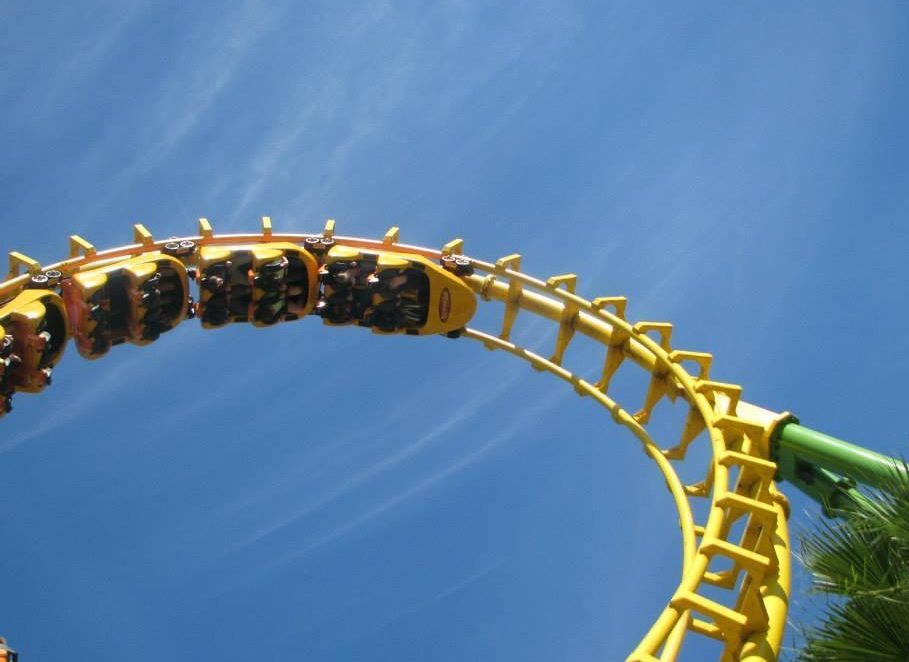You know that feeling you get when you embark upon that exciting rollercoaster for the first time? The one everyone has raved about? I’m not talking about the wimpy “gentle” ones, but the really badass kinds, the kinds that leave your knees a quivering pool of jelly the moment you exit? Maybe you’re a thrill-seeker and you’ve been looking forward to this adventure. Or, maybe you’ve been dragged on this ride by someone else quite reluctantly. Maybe you thought you wanted to check it out, but now that you’re loaded up and on board, a twinge of cold feet is setting in. Whichever the case, your seatbelt is strapped and there is no turning back now. Your heart starts thumping, your pulse is racing, and your palms are sweaty as you nervously clutch the harness. You try not to think too hard about how that harness is the only thing holding you in, keeping you from plummeting to your death when that coaster kicks in. Gulp. An array of nervous thoughts flow through you as your trolley slowly climbs that first hill. You start asking yourself “do I let go and allow myself to thoroughly experience this or do I hang on for dear life and pray it’s over fast?”

I’m usually in the later camp. I tend to seek out the wild rides, only to experience a hint of cold feet once I’m headed up that first steep cliff. There are times when I’m taking it all in, enjoying the rush of adrenaline. Other times, I start wishing the ride would end and hope I don’t toss my cookies all over the people in front of me. There are some rides I just have to be in the right mindset to attempt. The Hulk at Islands of Adventure in Orlando, Florida is one of those rides. The first time I rode it, I was feeling pretty adventurous, but as soon as my cart catapulted into the air at lightning speed, I felt my heart lurch into my throat. My pulse raced so fast, I almost wondered if I was experiencing a heart attack. The intensity of adrenaline was tolerable at first, but by the middle of the ride as I was tossed around each loop, I felt the urge to close my eyes to survive it. I kept thinking to myself “if I could just pause it for a second, I can catch my breath.” But the ride didn’t pause. It kept looping and flopping in every which direction, hoisting my petrified numb limbs along with it. Finally, the ride slowed for a couple of seconds, allowing me to bravely reopen my eyes and survey the landscape around me. “Whew, I’m still alive,” I comforted myself and tried to calm my racing pulse. But, then I realized, I was only climbing another steep hill. So, instead of catching my breath and regaining my strength, I was too distracted in fearful anticipation of what crazy intense drop lay ahead at the top of that next hill.

Though I really loved the ride and thought it was one of the most exhilarating roller coasters I’ve ever experienced, I really appreciated it the most when it was over. I can’t tell you the relief I felt when the harness released me and I placed my wobbly feet back on solid ground. I was appreciative of the opportunity to experience it, but I definitely needed a little more time before I was ready to brave that adventure again. But, imagine for just a moment that relief never comes. What if you were stuck on that rollercoaster forever, with no hope of ever stepping off? Can you imagine the panicked feeling of knowing there was never an end in sight? You were destined to experience the highs, the lows, the loops, the descents, and the heightened state of adrenaline continuously for the rest of your life…
This is the best description I can think of to depict what it’s like to be a special needs parent. Sure, there are some exhilarating moments. And, maybe the thrill seekers are well equipped for the ride. But, even the most equipped would still eventually look for an ending. And the ending never comes. Just when the ride slows down and you hope to catch your breath, that next ascent up the hill arrives, leaving you in dreaded anticipation of what awaits you over the cliff.
It makes sense, then, that there are a huge percentage of special needs caregivers who live with Post-Traumatic Stress Disorder (known as PTSD). The constant state of heightened adrenaline, the dreaded anticipation of being launched over that cliff, the turmoil and chaos that ensues daily as you try to meet your child’s many needs. When you live in this chronic state of stress and anxiety, it is enough to overwhelm the nervous system. When people think of PTSD, they tend to think of veterans of war, affected by the trauma of witnessing massive explosions, horrific and graphic casualties, or experiencing the loss of some of their fellow comrades. One does not usually consider a parent caring for chronic medical or special needs as a qualification for “trauma”.
But, imagine these scenarios for a moment:
- You never know when the next public autism meltdown will occur with your child. You’re always bracing for it. Constantly in a heightened sense of alertness, combing the entries and exits for an escape plan the first sign of threat.
- You wake up with nightmares every night, reliving the time you had to administer the life-saving glucagon shot to your unconscious child in hypoglycemia to save their life. Every time you close your eyes, you picture your child lifeless on the floor.
- You have to help restrain your panicked, flailing child as they scream through one more set of needle pokes, MRI scans or IV fluids.
- You watch helplessly as the surgeons once again wheel your child away to the operating table for another surgery, unsure of what the results will be.
- You recieve a call from the school, informing you that your child has been bullied and physically attacked once again by their peers.
Now, imagine these situations were a daily occurance for you. You live each day in constant fear, constant hypervigilance and the same nightmare replays over and over like Groundhog Day. You can start to see how the label “trauma” is an all too accurate description. I think a lot of parents don’t know they are living with PTSD. Perhaps it’s because that “P” kind of throws us. The word “post” implies that our trauma is now over. That we are now living in the aftermath. But, for a lot of parents, it will never end. There is no “after” until we have left this Earth. But, even then, so many parents face the biggest fear of all: what happens to my child when I am gone? Who will care for them then?

So, what do we do when our “P” won’t come? How do we cope with this rollercoaster of life? Do we clench our teeth, close our eyes, and hunker down as firm as possible while the ride loops on forever? Or, do we take our hands off that harness and live in each moment, wherever that trolley decides to throw us? Either approach will not stop the ride. So, it’s up to us how we choose to spend it. I am no trauma therapist and do not pretend to be an expert in this field. I also recognize that my trauma experience may look different from another’s trauma. But, I do find that the mindfulness approach improves my coping skills significantly. Researchers have confirmed that when applied correctly, mindfulness practices can be very helpful in relieving some of the symptoms induced by toxic stress and PTSD.
Mindfulness, in a nutshell, is a practice of being present in the moment. It is an awareness of the sights, sounds, smells, tastes and touch we experience in our environment, free of judgement. Though it was derived from Buddhist traditions, what mindfulness looks like for me is a release of control to God. It is recognizing that I am not the rollercoaster conductor. Whether I like it or not, my life is in his hands. I can clench, scream, close my eyes, or vomit. I can live in fear of what bump or tilt lays around the next corner. But, that fear will not magically change the rolleroaster’s course. For a control freak like me, this is a concept I struggle with on the daily!
“And, which of you being anxious can add a single hour to his span of life?” Matthew 6:27
“Therefore do not be anxious about tomorrow, for tomorrow will be anxious for itself. Sufficient for the day is its own trouble.” Matthew 6:34

How will you handle this rollercoaster of life? I know my “P” may never come. Or, perhaps my child with autism is high-functioning enough that there will be a “P” for me. Perhaps there will be a miracle cure for diabetes in my daughter’s lifetime. Time will only tell. I choose to let go of the worry of tomorrow and focus instead on the gift of today. For now, I’ve traded in my “P” (“post”) for a new “P”: “Present”. And that is how I live sufficient for the day.
*If you or someone you know appears to have symptoms of PTSD, please consult a mental health or medical professional. This blog is not intended as a substitute for mental health treatment.
For more like this in the future, you can subscribe to the blog or follow me on Facebook or Instagram. Check out more special needs resources on my Shop page, as well. Other posts you may like:
